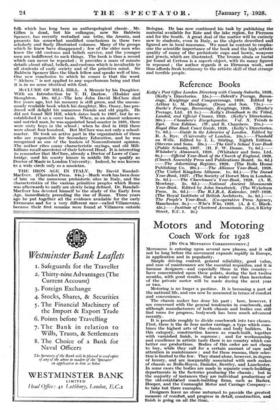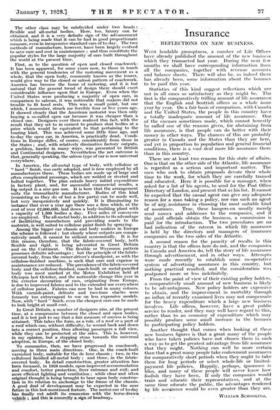Motors and Motoring
Coach Work for 1928
[By OUR MOTORING CORRESPONDENT.]
Moronism is entering upon several new phases, and it will not be long before the movement expands rapidly in Europe, in application and in popularity. Simple driving control, general reliability, good value, and ease of maintenance are the essential requisites, and it is because designers-and especially those in this country- have concentrated upon these points, during the last twelve months, with good results, that a wider use than heretofore of the private motor will be made during the next year or two.
Motoring is no longer a pastime. It is becoming a part of the national life, and can now be measured in terms of comfort and convenience.
The chassis maker has done his part ; here, however, I am concerned with the general tendencies in coachwork, and although manufacturers of both chassis and bodies can still find room for progress, bodywork has been much advanced recently.
It is possible roughly to divide coachwork into two classes. First, there is the de luxe motor carriage, a type which com-
bines the highest arts of the chassis and body builders. In this category, construction known as coach-built, together with varnished finish, is supreme ; and for workmanship and excellence in artistic taste there is no country which can better our productions. Bodies of this order are not cheap to buy, while they call for a certain amount of care and attention in maintenance • and for these reasons, their selec-
tion is limited to the few. :They stand alone, however, in degree of luxury, and are inseparably associated with such makes
of chassis as Rolls-Royce, Daimler, Bentley, and Lanchester. In some cases the bodies are made in separate coach-building departments in the factories producing the chassis ; but in the majority of instances they are individual productions of the old-established coach-building firms, such as Barker, Hooper, and the Connaught Motor and Carriage Company- to take but three examples.
Designers leave no stone unturned to provide the greatest measure of comfort, and progress in detail, construction, and finish is going on all -the-time. -
The other clam.; inilY be subdivided under two heads : flexible and all-metal bodies. Here, too, luxury can be obtained, and it is a very definite sign of the advancement which is being made that it can be had in good proportionate measure, even in inexpensive standard cars of to-day. The two methods of manufacture, however, have been largely evolved to save care and cost in maintenance ; and thus constitute the popular styles for the large majority of cars built throughout the world at the present time.
First, as to the question of open and closed coachwork- It has been apparent, for some years now, to those in touch with the general tendencies of the motoring movement as a whole, that the open body, commonly known as the tourer, would give way to the closed or saloon pattern of coachwork. America has become the home of motoring, and it is but natural that the general trend of design there should exert considerable influence upon that in Europe. Even when the United States were producing a majority of open cars, in comparison to saloons, it was noticeable that makers did not trouble to fit hood rests. This was a small point, but one which, I remember, struck me forcibly four or five years ago. It showed clearly that the American motorist was then only buying a so-called open car because it was cheaper than a closed one. Designers over there realized this fact, with the result that they set to in earnest to produce shut bodies at a price which would be equivalent to that pertaining to the touring kind. This was achieved some little time ago, and to-day the open car, in America, is practically dead. Condi- tions in Europe differ, of course, considerably from those in the States ; and, with relatively diminutive factory outputs, a problem, harder in many ways, was presented to British and Continental designers. Nevertheless the net outcome is that, generally speaking, the saloon type of car is now universal everywhere.
In America, the all-metal type of body, with cellulose or " hard " finish, was early adopted, and is now employed by all manufacturers there. These bodies are made up of large and often complicated pressings, which are welded or riveted and bolted together. The plan entails heavy initial expenditure in factory plant, and, for successful commercial results, a big output is a sine qua non. It is here that the arrangement suits the transatlantic manufacturer. Bodies of this kind (consisting as they do of but a few parts) can be made well, but very inexpensively and quickly. -It- is illuminating to instance that over a year ago there was a firm which, at the cost of over £2,000,000, laid down a body-building plant with a capacity of 1,500 bodies a day. Five miles of conveyors are employed. The all-metal body, in addition to its advantage of facilitating manufacture and providing assets to the inotorist, is well suited to cellulose paint finish by spraying.
_Among the bigger car chassis and body makers in Europe the scheme is followed ; but clearly where outputs are compa- ratively 'small, it cannot be utilized economically. It is for this reason, therefore, that the fabric-covered w body, both flexible and - rigid, is being advocated in Great Britain and on the. Continent. The flexible or Weymann pattern possesses definite advantages ; but the principle of the fabric- covered body, from the owner-driver's standpoint, as with the cellulose-finished machine, is such that care and expense in maintenance are reduced. The prevalence of the fabric-covered body and the cellulose-finished, coach-built or metal-panelled body was most marked at , the Motor Exhibition held at Olympia last October, and the noticeable change this year in the exterior decoration of cars, originating from Europe, is due to improved fabrics and to the extended use everywhere of cellulose paint. Fabrics can now be had in many colours. With varnish-paint, delicate and two-tone shades were formerly too extravagant to use on less expensive models. Now, with hard " finish, even the cheapest cars can be made to look bright at small cost.
In Great Britain, a number of designers aim, at the present time, at a compromise between the closed and open bodies, and it is but just to say that a fair measure of success is being attained. This takeii the form, as a -rule, of a roof or a part of a roof which can, without difficulty, be wound back and down into a correct position, thus allowing passengers a full view, while they can be protected at the sides. This is, however, in my opinion, but a stepping stone towards the universal adoption, in Europe, of the closed tiody.
To summarize, then, we have progressed in coachwork, moving in three main directions.- One, in the coach-built varnished body, suitable for the de luxe chassis ; two, in the cellulosed finished all-metal body ; and three, in the fabric- covered body. In detail construction, greater attention has been focussed, in 1928 models, upon improved accommodation and comfort, better protection, freer entrance and exit; and
more efficient lighting and ventilation; clear and often original thought is being brought to ber upon body construc- tion in its relation to anchorage to the frame of the chassis.c A good deal of development may be expected in- the near future in this last-mentioned feature. The motor-car of to-day has finally cut adrift' its' connexion with 'the hnise-draWn vehicle ; and this is aspuredly atiga,of headway.







































 Previous page
Previous page